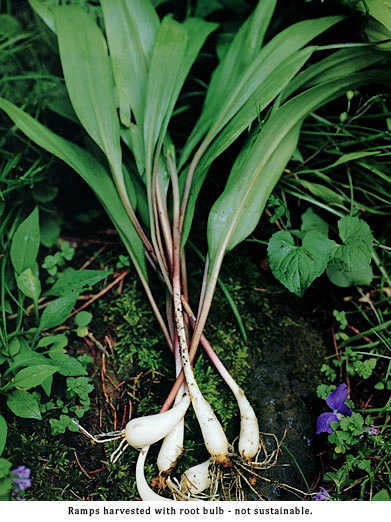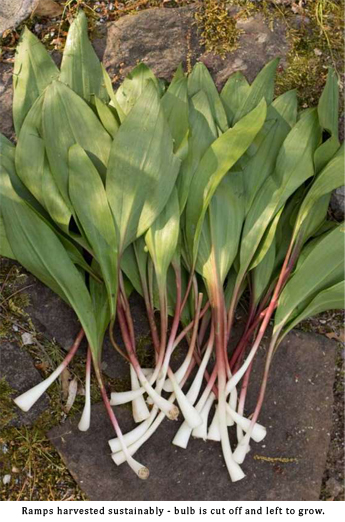 Allium tricoccum is a North American species of wild onion widespread across eastern Canada and the eastern United States, appearing in mid-April and lasting until mid-May. Allium tricoccum is a North American species of wild onion widespread across eastern Canada and the eastern United States, appearing in mid-April and lasting until mid-May.
Early settlers and Indigenous peoples regarded them as a spring tonic, relying on their restorative qualities after long, hungry winters.
Foraging Ramps
 Look for ramps underneath dense deciduous forest canopies in well-drained soil that's rich with organic matter with north-facing slopes. Look for ramps underneath dense deciduous forest canopies in well-drained soil that's rich with organic matter with north-facing slopes.
They're easily recognized by their 1, 2, or 3 broad leaves measuring 1 to 2 1/2 inches wide and 4 to 12 inches long.
Unfortunately for ramps, they're super-trendy these days. Chefs, foodies, and other ramp-lovers flock to the forests by the thousands for a chance to bask in their gourmet-ness. Over picking and careless harvesting is taking a toll on ramp populations putting them at risk. The implications of over-harvesting are having huge implications on the demand for these delicacies.
 Traditionally, Indigenous peoples dug ramps by leaving the roots. This is done by cutting off the bottom of the bulb with a knife while it's still in the ground. Sustainably harvesting of ramps takes more time that just yanking them out by the handful. Traditionally, Indigenous peoples dug ramps by leaving the roots. This is done by cutting off the bottom of the bulb with a knife while it's still in the ground. Sustainably harvesting of ramps takes more time that just yanking them out by the handful.
The most sustainable way to harvest ramps is to cut only one leaf, leaving the bulb and second leaf to continue growing. This is least impactful on the soil, the plant, and the colony as a whole. In fact, the leaves are the best part, anyway, and taking only leaves is the best way to ensure the colony will remain viable.
DO NOT take more than you need. Leave a good size patch behind so that they will provide you with food for the next year.
Storing & Preserving Ramps
Both leaves and bulbs can be eaten. They're best used fresh, but both can be put away for eating later in the year.
The easiest way to store ramp bulbs is by freezing: Simply cut off the greens, clean the dirt off the bulbs and cut off the roots (if your ramps still have roots). Then spread the bulbs out on a cookie sheet covered with waxed paper, making sure they are not touching and then freeze. This prevents them from sticking together.
Once they're frozen, put them in jars or plastic containers, seal tightly and put in the freezer for up to six months. You can also wrap them individually in wax paper and store frozen in sealed jars.
Bulbs can also be pickled using similar recipes as for pickled onions.
The greens won't last long fresh and deteriorate when frozen. They can be dried, but they lose a lot of their flavor. Best way to preserve the greens is by making ramp compound butter or ramp pesto. Use any pesto recipe and substitute in the ramp green. Either can be stored in the refrigerator in the short term or frozen for use later.
For short term storage put ramp greens in the refrigerator as soon as possible. They should be stored un-cleaned. If a refrigerator is not immediately available ramps can be kept with the bulbs submerged in a bucket of water and placed in a cool shaded area.
The leaves will start to wilt in the refrigerator after 4 days or so and in the bucket after a day or so depending on temperature.
Cooking & Eating Ramps
Ramp bulbs and leaves can be diced and used just as you would use onions, green onions, leeks, chives and garlic, but they are much more potent. They pair well with any pasta recipe, eggs, mushrooms, potatoes, stir fry or raw green salad.
Nutritional Facts
One 3.5-ounce (100-gram) serving of cooked leeks has only 31 calories. While low in calories, they are high in nutrients such as pro-vitamin A, carotenoids, including beta carotene.
Your body converts these carotenoids into vitamin A, which is important for vision, immune function, reproduction, and cell communication.
They’re also a good source of vitamin K1, which is necessary for blood clotting and heart health.
Meanwhile, wild ramps are particularly rich in vitamin C, which aids immune health, tissue repair, iron absorption, and collagen production. They offer about twice as much vitamin C as that of the same quantity of oranges.
They are also considered to be a good source of manganese, which helps to reduce premenstrual syndrome (PMS) symptoms and promote thyroid health.
Ramps or leeks also provide small amounts of copper, vitamin B6, iron, and folate.
|